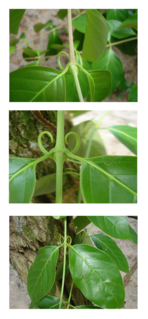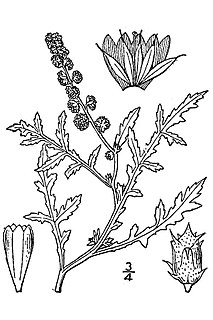The Peace of Callias is a purported peace treaty established around 449 BC between the Delian League and Persia, ending the Greco-Persian Wars. The peace was agreed as the first compromise treaty between Achaemenid Persia and a Greek city.
Callias was an Ancient Greek statesman, soldier and diplomat, active in 5th century BC. He is commonly known as Callias II to distinguish him from his grandfather, Callias I, and from his grandson, Callias III, who apparently squandered the family's fortune.

Paulownia tomentosa, common names princess tree, empress tree, or foxglove-tree, is a deciduous hardwood tree in the family Paulowniaceae, native to central and western China. It is an extremely fast-growing tree with seeds that disperse readily, and is a persistent exotic invasive species in North America, where it has undergone naturalisation in large areas of the Eastern US. P. tomentosa has also been introduced to Western and Central Europe, and is establishing itself as a naturalised species there as well.

Terminalia elliptica is a species of Terminalia native to southern and southeast Asia in India, Nepal, Bangladesh, Myanmar, Thailand, Laos, Cambodia, and Vietnam. It is a prominent part of both dry and moist deciduous forests in southern India up to 1000 m.
Callias was an ancient Athenian aristocrat and political figure. He was the son of Hipponicus and an unnamed woman, an Alcmaeonid and the third member of one of the most distinguished Athenian families to bear the name of Callias. He was regarded as infamous for his extravagance and profligacy.
Callias of Chalcis, son of Mnesarchus, together with his brother Taurosthenes, succeeded his father as tyrants of Chalcis. Callias formed an alliance with Philip of Macedon against Plutarch, tyrant of Eretria, with the view of extending his authority over the whole of Euboea, a design which, according to Aeschines, he disguised as a plan for uniting in one league the states of the island and establishing a general Euboean congress based at Chalcis.

Uncaria tomentosa is a woody vine found in the tropical jungles of South and Central America. It is known as cat's claw or uña de gato in Spanish because of its claw-shaped thorns. The plant root bark is used in herbalism for a variety of ailments, and is sold as a dietary supplement.
The Wych Elm cultivar Ulmus glabra 'Tomentosa' was first listed as Ulmus tomentosa by Kirchner in Arboretum Muscaviense (1864). The Hesse Nursery of Weener, Germany, distributed an Ulmus montana tomentosa in the 1930s. Green listed it as a wych elm cultivar.
Ulmus wallichiana var. tomentosa was identified by Melville & Heybroek after the latter's expedition to the Himalaya in 1960.

Tilia tomentosa, known as silver linden in the US and silver lime in the UK, is a species of flowering plant in the family Malvaceae, native to southeastern Europe and southwestern Asia, from Romania and the Balkans east to western Turkey, occurring at moderate altitudes.
Callias, sometimes called by the nickname Schoenion (Σχοινίων), was a poet of the Old Comedy, not to be confused with the three Athenian aristocrats named Callias, the last of which, Callias III, appears in Plato's Protagoras.

Arctostaphylos tomentosa is a species of manzanita known by the common name woollyleaf manzanita or woolley manzanita. This shrub is endemic to California.

Prunus tomentosa is a species of Prunus native to northern and western China, Korea, Mongolia, and possibly northern India. Common names for Prunus tomentosa include Nanjing cherry, Korean cherry, Manchu cherry, downy cherry, Shanghai cherry, Ando cherry, mountain cherry, Chinese bush cherry, and Chinese dwarf cherry.

Anne-Marie Gaillard, known as Nina de Villard de Callias, Nina de Callias or Nina de Villard, was a French composer, pianist, writer, and salon hostess.

Ambrosia tomentosa, the skeletonleaf bur ragweed, silverleaf povertyweed, or skeleton-leaf bursage, is a North American species of perennial plants in the.

Erebia callias, the Colorado alpine, is a member of the Satyridae subfamily of the Nymphalidae butterflies. It is found in alpine areas of Wyoming and Colorado in the U.S. Rocky Mountains as well as various mountain ranges in eastern Asia.

Morchella tomentosa, commonly called the gray, fuzzy foot, or black foot morel, is a species of fungus in the family Morchellaceae. M. tomentosa is a fire-associated species described from western North America, formally described as new to science in 2008.
Calliini is a tribe of longhorn beetles of the subfamily Lamiinae.
Callia is a genus of longhorn beetles of the subfamily Lamiinae.

Nancy Fish Barnum Callias D'Orengiani, Baroness was an English socialite who was the second wife of P. T. Barnum. The daughter of a successful English cotton mill owner, she started a relationship with Barnum, who was 40 years her senior. After the death of Barnum's first wife in 1873, they married the following year in both London and New York City. After his death in 1891, Barnum left Fish a large annuity, making her a wealthy widow.










